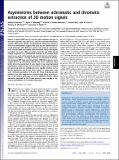Files in this item
Asymmetries between achromatic and chromatic extraction of 3D motion signals
Item metadata
| dc.contributor.author | Kaestner, Milena | |
| dc.contributor.author | Maloney, Ryan | |
| dc.contributor.author | Wailes-Newson, Kirstie | |
| dc.contributor.author | Bloj, Marina | |
| dc.contributor.author | Harris, Julie | |
| dc.contributor.author | Morland, Anthony | |
| dc.contributor.author | Wade, Alex | |
| dc.date.accessioned | 2019-06-24T09:30:02Z | |
| dc.date.available | 2019-06-24T09:30:02Z | |
| dc.date.issued | 2019-07-02 | |
| dc.identifier | 259145214 | |
| dc.identifier | 203f16b1-e3d4-4b66-abc7-dddef2951f35 | |
| dc.identifier | 31209058 | |
| dc.identifier | 85068264248 | |
| dc.identifier | 000473427900068 | |
| dc.identifier.citation | Kaestner , M , Maloney , R , Wailes-Newson , K , Bloj , M , Harris , J , Morland , A & Wade , A 2019 , ' Asymmetries between achromatic and chromatic extraction of 3D motion signals ' , Proceedings of the National Academy of Sciences of the United States of America , vol. 116 , no. 27 , pp. 13631-13640 . https://doi.org/10.1073/pnas.1817202116 | en |
| dc.identifier.issn | 0027-8424 | |
| dc.identifier.other | ORCID: /0000-0002-3497-4503/work/58984283 | |
| dc.identifier.uri | https://hdl.handle.net/10023/17952 | |
| dc.description | This work was supported by the Biotechnology and Biological Sciences Research Council Grants BB/M002543/1 (to A.R.W.), BB/M001660/1 (to J.M.H.), and BB/M001210/1 (to M.B.). | en |
| dc.description.abstract | Motion in depth (MID) can be cued by high-resolution changes in binocular disparity over time (CD), and low-resolution inter-ocular velocity differences (IOVD). Computational differences between these two mechanisms suggest that they may be implemented in visual pathways with different spatial and temporal resolutions. Here, we used fMRI to examine how achromatic and S-cone signals contribute to human MID perception. Both CD and IOVD stimuli evoked responses in a widespread network that included early visual areas, parts of the dorsal and ventral streams, and motion-selective area hMT+. Crucially, however, we measured an interaction between MID type and chromaticity. fMRI CD responses were largely driven by achromatic stimuli, but IOVD responses were better driven by isoluminant S-cone inputs. In our psychophysical experiments, when S-cone and achromatic stimuli were matched for perceived contrast, participants were equally sensitive to the MID in achromatic and S-cone IOVD stimuli. In comparison, they were relatively insensitive to S-cone CD. These findings provide novel evidence that MID mechanisms asymmetrically draw on information in pre-cortical pathways. An early opponent motion signal optimally conveyed by the S-cone pathway may provide a substantial contribution to the IOVD mechanism. | |
| dc.format.extent | 10 | |
| dc.format.extent | 1502227 | |
| dc.language.iso | eng | |
| dc.relation.ispartof | Proceedings of the National Academy of Sciences of the United States of America | en |
| dc.subject | 3D motion | en |
| dc.subject | Binocular vision | en |
| dc.subject | Color | en |
| dc.subject | RC0321 Neuroscience. Biological psychiatry. Neuropsychiatry | en |
| dc.subject | BF Psychology | en |
| dc.subject | NDAS | en |
| dc.subject | BDC | en |
| dc.subject | R2C | en |
| dc.subject.lcc | RC0321 | en |
| dc.subject.lcc | BF | en |
| dc.title | Asymmetries between achromatic and chromatic extraction of 3D motion signals | en |
| dc.type | Journal article | en |
| dc.contributor.sponsor | BBSRC | en |
| dc.contributor.institution | University of St Andrews. School of Psychology and Neuroscience | en |
| dc.contributor.institution | University of St Andrews. Institute of Behavioural and Neural Sciences | en |
| dc.identifier.doi | 10.1073/pnas.1817202116 | |
| dc.description.status | Peer reviewed | en |
| dc.identifier.grantnumber | BB/M001660/1 | en |
This item appears in the following Collection(s)
Items in the St Andrews Research Repository are protected by copyright, with all rights reserved, unless otherwise indicated.

